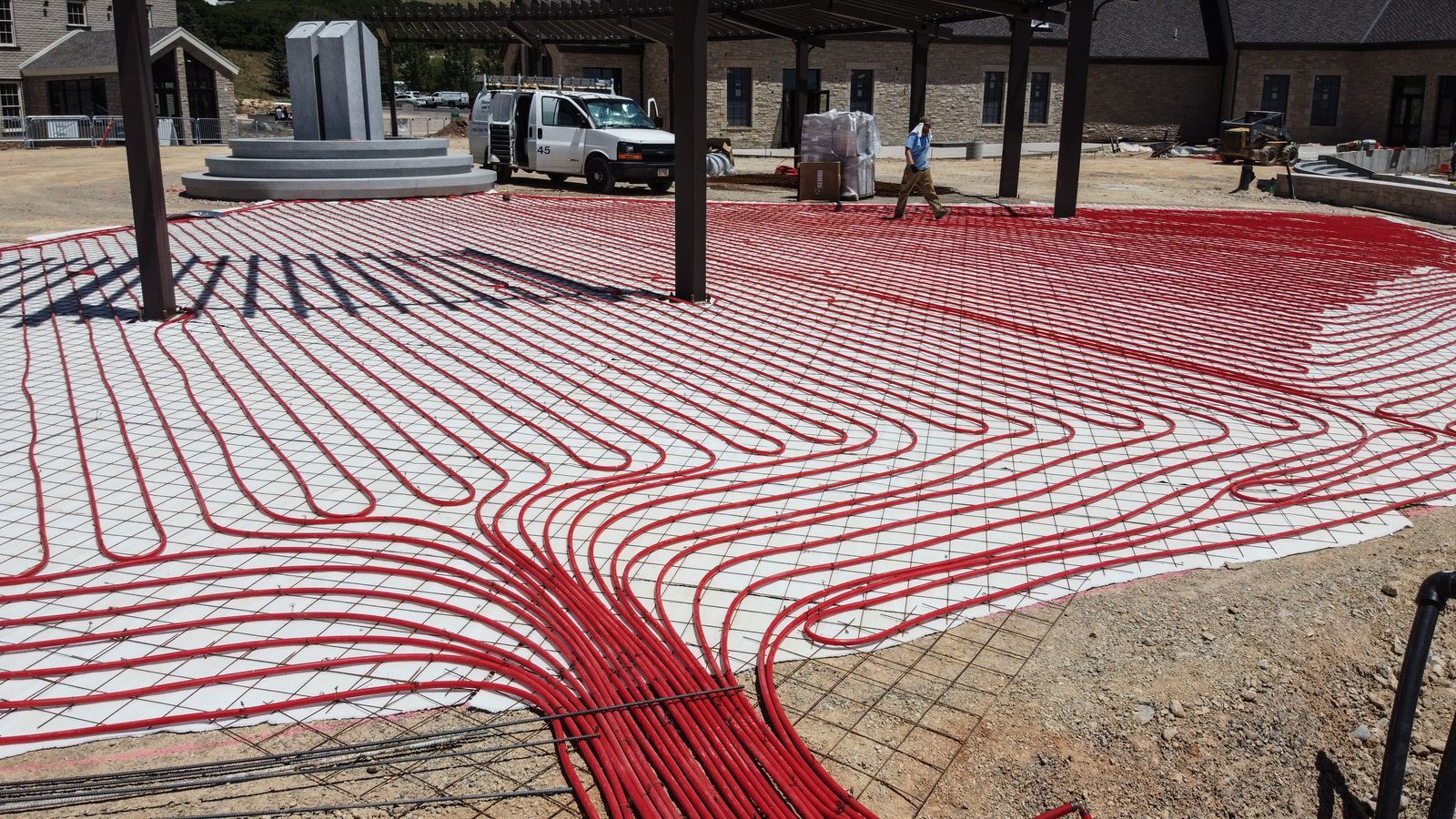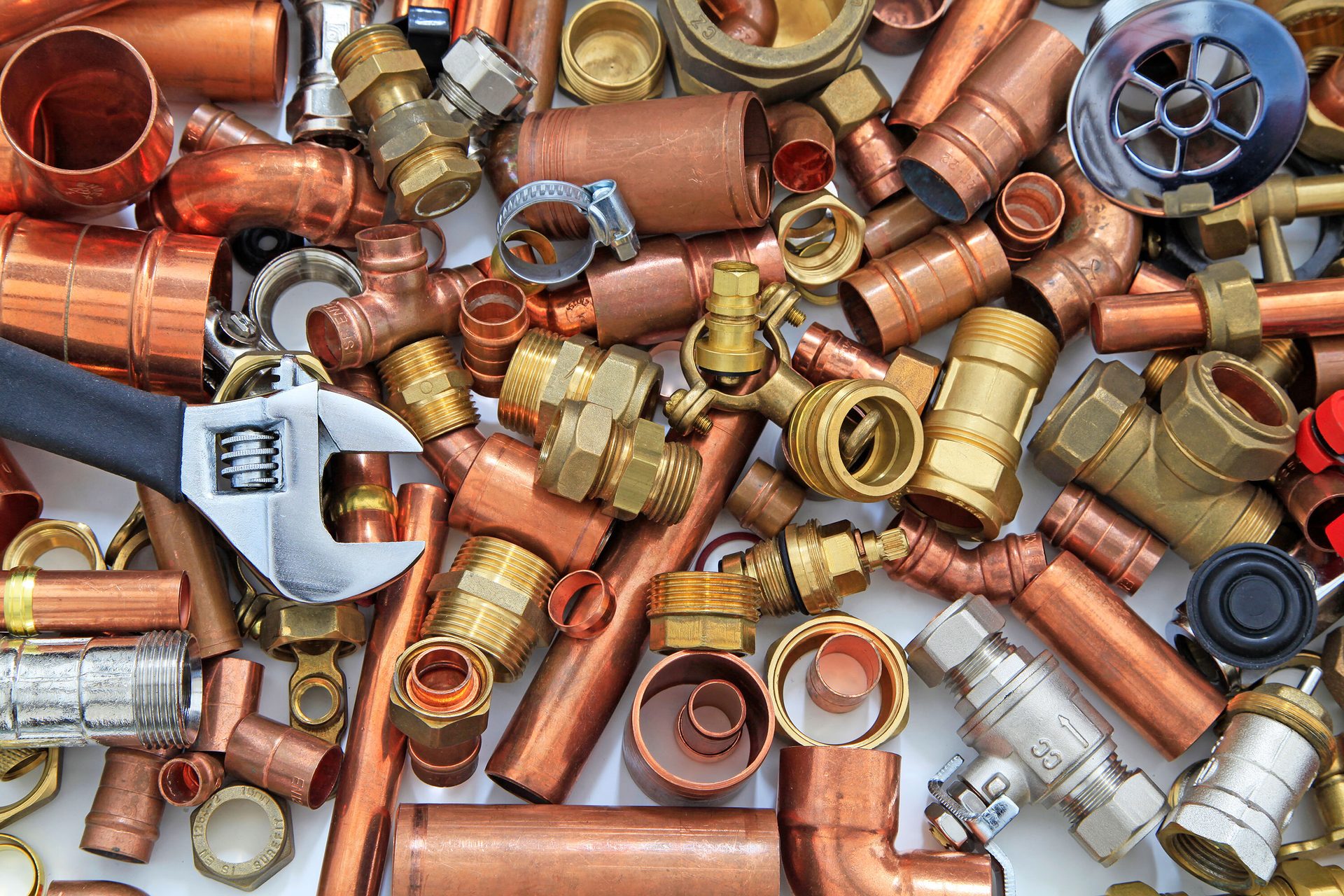How radiant snow melt systems are transforming winter safety around the U.S.
by Kristen Bayles
Life may be all summer fun and hot weather right now, but winter is on its way. While summer brings its own set of problems, things turn to havoc when winter storms roll in. It may seem easy enough for many to avoid the pains of winter in your own home by relaxing by the fire and cranking up the heat, but for businesses of all types, that simply isn’t an option. Life must go on despite the ice; many high-risk facilities like hospitals, museums, nursing homes and more can’t shut down or slip up.
From emergency room entrances to ambulance bays and parking ramps, these critical access points must remain clear. This is important all year round, but during the winter, heavy snow and ice can cause major safety concerns. Unfortunately, traditional snow-removal methods are labor intensive, and leave facilities and homeowners alike vulnerable to slip-and-fall incidents that aren’t just expensive; they can be deadly.
Building and home owners, facility managers and engineers alike are turning to radiant snow melt systems as a proactive, long term solution for winter safety and liability reduction.
Slip-and-fall accidents are among the most common liability claims in winter, according to AAA. Winter storms have cost billions of dollars in insured losses, just in the past few years. For businesses, that’s a major issue. In healthcare facilities where patient safety and uninterrupted access are non-negotiable, the stakes are even higher. Radiant snow melt systems can eliminate surface ice before it becomes a hazard, dramatically reducing legal exposure.

Rehau installed a hydronic snow and ice melting system for This is the Place Heritage Park in Salt Lake City, Utah. Warm water and/or glycol solution is circulated through a network of pipes embedded in the concrete slabs to melt snow and ice above. Image courtesy of Rehau.
Safety where it matters most
While plowing and salting have long been the standard for winter maintenance, they can’t match the precision or reliability of a properly designed snow melt system. These hydronic or electric systems activate automatically, require less manual intervention and provide uniform melting exactly where it’s needed most. Other traditional methods, such as chemical deicers, can also be harsher on the environment. Technical Sales Manager of the Midwest and Northeast regions for Rehau, Jeff Schneider, told us, “Beyond the issue of liability, automated hydronic SIM solutions also offer significant operational convenience and cost efficiencies by eliminating the need for manual snow removal and reducing reliance on harsh ice melting chemicals or salt, ultimately providing property owners with peace of mind that snow and ice are proactively managed without ongoing manual intervention or premature degradation of surfaces.”
According to Julia Billien, owner and president of WarmlyYours Radiant Heating, the number one reason that home and business owners, facility managers and organizations install radiant heating is simple: safety. “We believe no one should have to risk a fall just trying to get to their front door or walk into a place of worship.”
A memorable project for the WarmlyYours team was a heated driveway in Bartlett, IL at the Jain Society Temple of Chicago. The project featured the use of the company’s snow melting mats, installed with fresh asphalt, as well as a control panel with automatic controls and a manual override. This project was vital to the church, according to Billien. “Their community wanted to make sure that all visitors could arrive safely no matter what winter threw their way.” The snowmelt system installed ensures that roads remain safe for every person who comes to the temple, regardless of the weather.
ADVERTISEMENT
Kolyn “Coach” Marshall, senior applications instructor at Watts, also recalled a particular job that was prompted by a need for a safer environment. Eight years ago, the Wellspan York hospital built a new helipad; part of a $50 million modernization of its emergency department. The new heli-pad needed to be able to safely transport patients no matter the weather. According to Dave Yates, then president of the firm, “There’s an art to maintaining just the right degree of heat within a concrete helicopter pad to ensure that it’s free of ice and snow – which can temporarily blind pilots at a time when they’re most vulnerable.”
Rooftop helipads, while incredibly important, also pose risks to those below, according to Marshall. “We usually focus on the helicopter and the risk flying debris can cause to the helicopter, but this debris also poses a risk to those on the ground below. If a helicopter is able to kick up snow and ice from the roof there is a potential for that debris to be tossed over the roof’s edge and down to those on the sidewalks below.” That’s why snowmelt systems are the ideal choice in cases such as these. “Eliminating the snow and ice before it’s an issue is not only beneficial to the helicopter and those moving to and from, but also to those unaware by-standards on the ground below.”
“According to workers’ compensation experts SFM, 25% of ice and snow-related falls occur in parking lots, so any structure with a parking lot is a good candidate for a snow and ice melting system.” Uponor’s North America Heating and Cooling Category Manager, Tim Botten, told us.
Sidewalks, parking lots, hospitals, geriatric facilities, airports and museums – the list goes on of projects that companies have been able to ensure safety through the use of radiant snow melt. When accessibility and operational reliability are on the line, especially for critical facilities, the smartest solutions start from the ground up.

WarlmyYours installed two heated driveways for a temple in Chicago, ensuring that their community could come to worship without fear of icy roads. Image courtesy of WarmlyYours
The sustainable choice
Safety, while certainly one of the main reasons that many people decide to install radiant snow melt systems, is not the only reason that many are turning to this technology. “While mitigating slips and falls is important, there are also labor costs, equipment costs and sustainability factors that play an important role.” Botten said. The developer of an outdoor mall in Canada, Royalmount, came to Uponor for help with a snow and ice melting system throughout the property that wouldn’t damage the surrounding ecosystem. “Unlike harsh deicing chemicals, a snow and ice melting system quickly and effectively eliminates winter hazards without the need for toxic substances that can harm trees and plants or even be tracked indoors via shoes and boots.”
This project, according to Botten, is the perfect example of using snow melt as part of a broader sustainability plan. “A key component of the project’s carbon neutrality is its use of a dual energy transfer loop primarily powered by geothermal energy. The system uses 150 geothermal wells, which are 600 feet deep, to provide a significant portion of the project's energy needs. Hydronic radiant snow and ice melting systems are ideal for combining with geothermal ground source heat pumps.”
Julia Billien of WarmlyYours also mentioned a project that the company worked on: the Illinois Holocaust Museum Education Center. “Their values around sustainability and stewardship come through in everything they do. It made perfect sense for them to integrate a snow melting system for a heated walkway into their LEED Gold-certified facility.” Sustainability was something very important to this project; that’s why they opted for a heated walkway system. “They understood that a sustainable space is also a safe space. You don’t have to compromise on one to get the other.”
In fact, there are several environmental reasons to consider a radiant snow system instead of traditional methods, like reduction in salt and chemical use. Traditional deicing methods rely heavily on rock salt and chemical agents, which can contaminate groundwater and local waterways or damage surrounding vegetation, soil quality and infrastructure. “By keeping surfaces clear of snow and ice without the need for de-icing chemicals, the system helps prevent environmental runoff and reduces damage to surrounding landscapes and infrastructure,” according to Botten. And, in the words of Billien, “Small business owners are proud that they don’t have to rely on rock salt and prayer to keep their storefronts accessible. When you invest in people’s safety, it shows. You see it in fewer panicked phone calls. Fewer slips. More peace of mind.”
Radiant snow melt systems significantly reduce — and in some cases eliminate — the need for diesel-powered snow removal equipment such as plow trucks, skid steers and snow blowers. This not only cuts down on fuel consumption and emissions, but also reduces the noise and disruption these machines often cause, particularly in dense urban areas or sensitive environments like hospitals and schools.

Radiant snow melt systems are paramount to keeping businesses running smoothly, no matter what time of year it is. Image courtesy of Watts
In addition to lowering greenhouse gas emissions associated with heavy equipment, radiant systems help preserve the integrity of driveways, walkways and other surfaces. Repeated plowing and scraping can cause physical damage to pavement, concrete and pavers, leading to faster material degradation. Over time, this results in costly repairs or complete resurfacing, which carries its own environmental footprint in terms of materials, machinery and energy use.
By maintaining a consistent, ice-free surface throughout the winter without physical abrasion or chemical corrosion, snow melt systems extend the lifespan of hardscaping. Fewer repair cycles and less frequent resurfacing mean less construction-related waste, fewer emissions from manufacturing and transport of replacement materials, and reduced demand for landfill space. It’s a long-term sustainability win — minimizing both environmental impact and maintenance costs over the life of the surface.
What’s next in radiant heat?
While radiant snow melt technology is already quite the feat, companies aren’t resting on their laurels. They’re recommending technology that takes things a step further. At Watts, WarmlyYours, Uponor and Rehau, the recommendation is the same: control. “Utilizing a control system that has internet-based connectivity for up-to-date weather forecasting as well as moisture sensors that can detect moisture and turn the system on/off based on [the results] is critical to a well performing SIM system that is using energy only when needed.” Rehau’s Jeff Schneider told us.
“Instead of heating everything at once, a zoned control lets you prioritize. Let’s say a business has both a walkway and a staircase. If elderly visitors or customers with mobility concerns are common, you can choose to heat the stairs first – because that’s where the risk is greatest. . . Where are the danger zones? Where are people most likely to walk? That’s how you get both safety and efficiency in one package.” Said Julia Billien of WarmlyYours.
Watt’s Kolyn “Coach” Marshall also noted that there are several control strategies available now. “The basic format includes a slab sensor with snow detection capabilities. These operate on an as-needed basis. The sensor detects snow fall and turns on. . . When the sensor no longer detects snow the control enters its off cycle which generally consists of a certain amount of post-operational runtime to help prevent any remaining water from re-freezing.” While these systems work well, according to Marshall, they can be slow. “ A more advanced, or smart, system involves connecting the control to the internet. This allows the controller to interface with the local weather reports. If snow is predicted the controller will preemptively turn on a few hours before the anticipated snowfall is to begin. This allows the slab to be at melting temperature when snowfall begins reducing or eliminating the delay and any snow or ice accumulation.”
By maintaining a consistent, ice-free surface throughout the winter without physical abrasion or chemical corrosion, snow melt systems extend the lifespan of hardscaping. . . It’s a long-term sustainability win — minimizing both environmental impact and maintenance costs over the life of the surface.
“While these systems can be used with manual, timed, or automatic controls, sophisticated smart systems that optimize melting and energy consumption are the best solution to ensure immediate response while maximizing system efficiencies,” Uponor’s Tim Botten agreed.
With innovations like internet-connected weather forecasting, zoning capabilities and real-time moisture sensors, today’s systems are designed to deliver targeted performance with minimal energy waste. As technology evolves, the integration of smart controls ensures snow melt systems work not just harder, but smarter — enhancing both safety and sustainability, right when and where it matters most.
For many people, snow is little more than a seasonal inconvenience. But, for hospitals, businesses and institutions where safety and accessibility can’t wait for a plow truck, it’s a serious risk: one that demands a serious solution. Radiant snow melt systems offer more than just convenience; they deliver peace of mind, operational resilience and a measurable reduction in liability, labor and environmental impact.
With the growing emphasis on sustainability, smart controls and year-round facility preparedness, it’s clear that snow melt technology is so much more than just a luxury. It’s an investment in the future. As more organizations move toward proactive winter readiness strategies, radiant systems are proving that the safest, smartest solutions really do start beneath the surface.

Lead photo courtesy of BWFolsom / iStock / Getty Images Plus
Kristen Bayles is the Associate Editor for Plumbing & Mechanical and Supply House Times. Originally from Monroeville, Alabama, her family worked in the plumbing industry for many years. Kristen holds a Bachelor’s degree in English with a specialization in Language and Writing from the University of Montevallo. Prior to joining BNP in 2025, she worked as an editor in the jewelry industry.

